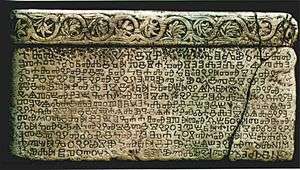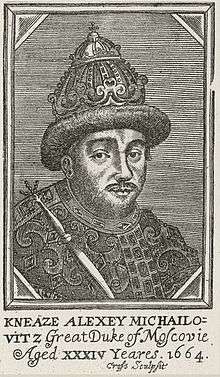Knyaz
Knyaz or knez is a historical Slavic title, used both as a royal and noble title in different times of history and different ancient Slavic lands. It is usually translated into English as prince, duke or count, depending on specific historical context and the potentially known Latin equivalents of the title for each bearer of the name. In Latin sources the title is usually translated as comes or princeps, but the word was originally derived from the Proto-Germanic *kuningaz (king).[1]
The female form transliterated from Bulgarian and Russian is knyaginya (княгиня), kneginja in Slovene and Serbo-Croatian (Serbian Cyrillic: кнегиња). In Russian, the daughter of a knyaz is knyazhna (княжна). In Russian, the son of a knyaz is knyazhich (княжич in its old form).[2]
The title is pronounced and written similarly in different European languages. In Serbo-Croatian and some West Slavic languages, the word has later come to denote "lord", and in Czech, Polish and Slovak also came to mean "priest" (kněz, ksiądz, kňaz) as well as "duke" (knez, kníže, książę, knieža).[3] In Sorbian it means simply "Mister" (from "Master". Compare French monsieur from mon sieur "my lord"). Today the term knez is still used as the most common translation of "prince" in Slovenian, Bosnian, Croatian and Serbian literature. Knez is also found as a surname in former Yugoslavia.[4]
Etymology

The etymology is ultimately a cognate of the English king, the German König, and the Swedish konung. The proto-Slavic form was кънѧѕь, kŭnędzĭ;[5] Church Slavonic: кънѧѕь,[6] kŭnędzĭ; Bulgarian: княз, knyaz; Old East Slavic: князь, knyazĭ; Polish: książę; Serbo-Croatian: knez / кнез; Czech: kníže; Slovak: knieža; etc., as it could be a very early borrowing from the already extinct Proto-Germanic Kuningaz, a form also borrowed by Finnish and Estonian (kuningas).[3][7]
Middle Ages
The meaning of the term changed over the course of history. Initially the term was used to denote the chieftain of a Slavic tribe. Later, with the development of feudal statehood, it became the title of a ruler of a state, and among East Slavs (Russian: княжество (kniazhestvo), Ukrainian: князівство (knyazivstvo) traditionally translated as duchy or principality), for example, of Kievan Rus'. In medieval Latin sources the title was rendered as either rex or dux. In Bulgaria, Boris I of Bulgaria changed his title to knyaz after his conversion to Christianity, but his son Simeon took the higher title of tsar soon in 913. In Kievan Rus', as the degree of centralization grew, the ruler acquired the title Velikii Knyaz (Великий Князь) (translated as Grand Prince or Grand Duke, see Russian Grand Dukes). He ruled a Velyke Knyazivstvo (Велике Князiвcтво) (Grand Duchy), while a ruler of its vassal constituent (udel, udelnoe knyazivstvo or volost) was called udelny knyaz or simply knyaz.
When Kievan Rus' became fragmented in the 13th century, the title Kniaz continued to be used in East Slavic states, including Kiev, Chernihiv, Novgorod, Pereiaslav, Vladimir-Suzdal', Muscovy, Tver, Halych-Volynia, and in the Grand Duchy of Lithuania.[8]
Russia

As the Tsardom of Russia gained dominion over much of former Kievan Rus', Velikii Kniaz (Великий Князь) (Great Kniaz) Ivan IV of Russia in 1547 was crowned as Tsar. From the mid-18th century onwards, the title Velikii Kniaz was revived to refer to (male-line) sons and grandsons of Russian Emperors. See titles for Tsar's family for details.
Kniaz (Russian: князь, IPA: [ˈknʲæsʲ]) continued as a hereditary title of Russian nobility patrilineally descended from Rurik (e.g., Belozersky, Belosselsky-Belozersky, Repnin, Gorchakov) or Gediminas (e.g., Galitzine, Troubetzkoy). Members of Rurikid or Gedyminid families were called princes when they ruled tiny quasi-sovereign medieval principalities. After their demesnes were absorbed by Muscovy, they settled at the Moscow court and were authorised to continue with their princely titles.
From the 18th century onwards, the title was occasionally granted by the Tsar, for the first time by Peter the Great to his associate Alexander Menshikov, and then by Catherine the Great to her lover Grigory Potemkin. After 1801, with the incorporation of Georgia into the Russian Empire, various titles of numerous local nobles were controversially rendered in Russian as "kniazes". Similarly, many petty Tatar nobles asserted their right to style themselves "kniazes" because they descended from Genghis Khan.
Finally, within the Russian Empire of 1809–1917, Finland was officially called Grand Principality of Finland (Finnish: Suomen suuriruhtinaskunta, Swedish: Storfurstendömet Finland, Russian: Великое Княжество Финляндское, romanized: Velikoye Knyazhestvo Finlyandskoye).
Polish-Lithuanian Commonwealth
As noted above, the title knyaz or kniaz became a hereditary noble title in the Grand Duchy of Moscow and the Grand Duchy of Lithuania. Following the union of the Kingdom of Poland and the Grand Duchy of Lithuania, kniaź became a recognised title in the Polish-Lithuanian Commonwealth. By the 1630s – apart from the title pan, which indicated membership of the large szlachta noble class – kniaź was the only hereditary title that was officially recognised and officially used in the Polish-Lithuanian Commonwealth. Notable holders of the title kniaź include Jeremi Wiśniowiecki.
South Slavic countries
In the 19th century, the Serbian term knez (кнез) and the Bulgarian term knyaz (княз) were revived to denote semi-independent rulers of those countries, such as Alexander Karađorđević and Alexander of Battenberg. In parts of Serbia and western Bulgaria, knez was the informal title of the elder or mayor of a village or zadruga until around the 19th century. Those are officially called gradonačelnik (градоначелник) (Serbia) and gradonachalnik (градоначалник) or kmet (кмет) (Bulgaria).
Bulgaria
- Prior to Battenberg, the title knyaz was born by Simeon I during the First Bulgarian Empire (9th–10th century). At the height of his power, Simeon adopted the title of tsar ("emperor"), as did the Bulgarian rulers after the country became officially independent in 1908.
- As of Bulgaria's independence in 1908, Knyaz Ferdinand became Tsar Ferdinand, and the words knyaz and knyaginya began to be used instead for the tsar's children – the heir to the throne, for example, held the title Knyaz Tarnovski (Prince of Turnovo").
Bosnia
In medieval Bosnia knez was title held by several of most powerful magnates (in Bosnia vlastelin) of the era, sometime along with an office title given to person through service to the monarch, such as Grand Duke of Bosnia, which was office of the supreme military commander of the realm. Other noble titles included the count, the duke and the prince. Among most influential of Bosnian nobleman with the title knez was Pavle Radinović of Radinović-Pavlović noble family.
Croatia
- knez was the monarchial title used by the medieval rulers of the Duchy of Pannonian Croatia and the Duchy of Littoral Croatia from the 7th to the 10th century, who were mostly titled as dux[9][10] and rarely as princeps[11][12] in Latin sources and translated as Dukes in English ones.
- knez[13] was, in the Late Middle Ages, a hereditary feudal title borne by Croatian vassal noble families who were great territorial magnates of high social class (such as knezovi Bribirski (Counts of Bribir), knezovi Krčki (Counts of Krk) and knezovi Zrinski (Counts of Zrin)) and went by the title of comes in Latin and Count in English.
Montenegro
- knjaz (књаз) was the ruler title used by the Petrović-Njegoš dynasty in Principality of Montenegro from 1852 until the establishment of Kingdom of Montenegro in 1905, translated as "Prince".
Serbia
- knez (кнез) or knjaz (књаз) is a common term used in Serbian historiography for Serbian rulers in the Early Middle Ages, who were titled archon in Greek.
- knez (кнез) or knjaz (књаз) was a noble title used by medieval rulers of the Principality of Serbia, Duklja, Travunija, Zachlumia and Moravian Serbia.
- knez (кнез) was a title borne by local Serbian chiefs under the Ottoman Empire. It was another name for the Ottoman Turkish rank of kodjabashi, held by local Christian chiefs.[14]
- obor-knez (обор-кнез) was a title borne by elected local native Serbian chiefs of the nahiyah (district of a group of villages) in the Ottoman Sanjak of Smederevo (also known as the Belgrade Pashaluk). The obor-knez was senior chief and responsible for his district's people and was their spokesman (intermediary) in direct relations with the Pasha, though usually through the sipahi, and was in charge of the transfer of taxes levied on the villages.
- knez (кнез) or knjaz (књаз) was the monarchial title used by Miloš Obrenović in Principality of Serbia, translated as "Prince". Serbia known as Kneževina Srbija (Кнежевина Србија) was de facto independent since 1817, becoming de jure independent with the 1869 constitution. The successors of Miloš used the title until 1882 when Serbia was elevated into a kingdom.
References
- de Madariaga, I. (1997) "Tsar into emperor: the title of Peter the Great", in Hatton, R.M. et al. Royal and Republican Sovereignty in Early Modern Europe, Cambridge University Press: Cambridge. ISBN 9780521026512, p. 354
- Даль В. Толковый словарь живого великорусского языка в 4-х т. М., 1956. Т. 2, с. 126; Рабинович М. Г. Очерки этнографии феодального города. М., 1978, с. 228.
- "князь". "Vasmer's Etymological Dictionary" online
- Фроянов И. Я. Киевская Русь. Л., 1980. С. 17
- Skok, Petar. Etimologijski Rječnik Hrvatskoga ili Srpskoga Jezika. 1972.
- Ed. Kurz, Josef. Slovnik Jazyka Staroslověnskeho: Lexicon Linguae Palaeoslavonicae. 1958.
- "knez". Oxford English Dictionary, 1989, online (subscription required)
- Великий князь // Слова давно минувших дней. Энциклопедия русской старины (speakrus.ru)
- "Borna". Croatian Biographical Lexicon by Miroslav Krleža Institute of Lexicography (online edition). Retrieved 2017-10-17.
- "Trpimir I". Croatian Biographical Lexicon by Miroslav Krleža Institute of Lexicography (online edition). Retrieved 2017-10-17.
- "Domagoj". Croatian Biographical Lexicon by Miroslav Krleža Institute of Lexicography (online edition). Retrieved 2017-10-17.
- "Branimir". Croatian Biographical Lexicon by Miroslav Krleža Institute of Lexicography (online edition). Retrieved 2017-10-17.
- "knez". Croatian Encyclopedia by Miroslav Krleža Institute of Lexicography (online edition). Retrieved 2017-10-17.
- Stavrianos, Leften Stavros (2000) [1958]. The Balkans Since 1453. C. Hurst & Co. Publishers. p. 224. ISBN 1850655510.
Sources
- Mihaljčić, R. (1999) Knez. in: Ćirković S.i R.Mihaljčić [ed.] Leksikon srpskog srednjeg veka, Beograd, str. 299-301
External links


.svg.png)